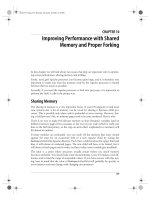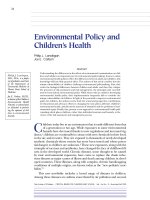War memory and Mizoguchi’s film
Bạn đang xem bản rút gọn của tài liệu. Xem và tải ngay bản đầy đủ của tài liệu tại đây (215.8 KB, 6 trang )
WAR MEMORY AND MIZOGUCHI’S FILM
Fumie Yatagai
ABSTRACT
This paper focuses on the Japanese film director called
Kenji Mizoguchi who worked not only the making films
but gave the caricature impact to the Japanese society. He was
touching with the Japanese philosophy and spirit before and after the
World War II.
He described the common life of the Japanese life,
especially tracing on how the women were dis-treated because of
the context of the machismo in the public and at home. Also, the
women were prohibited to have good education. The Japanese
women at that time had a harsh moment to find their identity.
For instance, as I experienced the poverty and
discriminations just to be a women, Mizoguchi’s film encouraged
me and opened a door to the new life.
INTRODUCTION
After 300 years of exclusion of foreigners since seventeenth
century, Japan had a great effort to learn and absorb the technology of
powerful countries such as Europe and America. Since Japan participated
in the World War I (1914-18) in the month of August, the political and
economic relationship between Japan and the Western countries was
enhanced and diplomatic negotiations with the West European countries
started to be further accelerated. On the basis of the economic power
gained by supplying weapons to the war-participant countries and the
Mr. Yatagai is an Ph.D. Research Scholar, Department of Journalism and Communication,
University of Madras, Chennai, India
42
WAR MEMORY AND MIZOGUCHI’S FILM
development of heavy industries, Japan in this period started changing
from the agriculture-centered system to industry-centered system.
Inflow of people from farming regions to cities increased the
population of city consumers, which led to the appearance of a new
working class people in the city areas who wished for new popular
entertainment. The new popular entertainment was nothing but film. The
concept “Lewisian Turning Point” which was proposed by Arthur Lewis,
an English Economist in the year 1945, became popular in the country.
According to this concept, when there is a lack of opportunity for the
laborer in the industry, the capitalist may give them job; however, reduce
the payment for the laborer. The laborers change their profession of
agriculture to industrial workers. In case of Japan, a good number of
villagers who were doing farming became city laborers.
However, the prosperity in the industrial arena and giving up of
agriculture in the villages led to the surplus of labor population. Later, due
to the Great Depression of economy, Japan took its route towards the
World War II (1939-45) along its imperial mission. The reason is that the
laborers, who did not get job in the Japanese cities, had to leave the
country and go to other Asian countries for the sake of labor. Japan’s trade
in the Asian countries and the desire to colonize the Asian countries led
them towards Asian Hegemony. It is the reason that the most of the
Japanese did not object their government joining a war because they had
been living in feudalism and patriarchal society.
The twentieth century was the era of wars. In particular, the
WW II destructed numerous cities in Japan. Many cities in Japan, except
Kyoto and Hokkaido, were bombed by the US Army. Because of this
almost all areas in Japan were destructed by fire. After the end of the war,
the US Army occupied Japan and established and reformed the
constitution of Japan.
Since Japan was bombarded twice by nuclear
TRIBHUVAN UNIVERSITY JOURNAL, VOLUME. XXIX, NUMBER 1, JUNE 2016
43
bomb attack, we Japanese had to reconstruct and rehabilitate our life from
a pile of ruins. Japanese worked very hard with a desire to build up the
country. The revolution of development started from nothing.
At the same time, Japan had developed the feeling of extreme
nationalism and started the invasion to other Asian countries under the
slogan of Asian hegemony. As a result of Japanese invasion, the culture
and life of the people became miserable in China, Korea and Taiwan
during this period.
Now, I introduce a Japanese film director, Kenji Mizoguchi, who
worked throughout Japan during this period. He has described the
mentality and philosophy of Japanese through his film from the pre-war to
post-war period.
In the period of pre-war, Mizoguchi made a film called ‘The
Osaka Elegy’ in the year 1936. This film was directed by Mizoguchi and
it was produced by the Daiichi Eiga. The story of the movie revolves
around the suffering father; the young daughter quits the job of telephone
operator and begins to work as a prostitute. Immediately after she fails to
repay the debt, she returns home but her father and brother did not warmly
receive her. Therefore, she once again gets out of the family and lives all
alone. She develops an innate impulse to go back home.
Through this movie, Mizoguchi portrays a woman who has lost place
to live in the family, a woman who is standing alone at the time of difficulties
in resistance to the patriarchy ideology of Japanese society. She, at last, brings
herself to a great ruin. There is no warm-hearted family existing in the
themes of many of Mizoguchi’s works in this period.
Mizoguchi himself was brought up in a feudalistic and a
patriarchial family. The heroines in his films in their depressions rely on
their fates. In the same period, he also made a film entitled “The 47 Ronin,”
It recounts a historical event in the backdrop of imperial influence in the
44
WAR MEMORY AND MIZOGUCHI’S FILM
East. He encouraged the Japanese government towards war, Cosidering it a
necessity. Indeed, it was obvious that Japanese government in this period
forced all directors to make films and stories which prompt the war; it was
only Mizoguchi who recaptures the Japan's motivation to war. Other film
directors were producing only action movies during this period.
However, after the war, Mizoguchi shifted his style. Let us
analyze the new style through the movie ‘Women
of the
night’. The
heroine of this film lives in Osaka, and her child is killed in an air raid.
She also loses her husband in the war. In a great despair, she sells herself
for money. Later, she meets her sister who came back from North Korea
and works as a night club dancer. While they live together, they face
severe problems from the male members of society. Hence, they
determine to take revenge on all men. In order to take revenge, they
become prostitutes. One day, they find out the heroine’s sister-in-law, who
also turns herself as a prostitute. At the last scene of this film, these
women begin a new life and return to the society. However, there is no
hope that they can come back to normal life. Ordinary women at that
period, like the heroine, have no technical skill because they did not go to
school or colleges. As a result, they do not get appropriate professions. It
was after the defeat of the WW II under the advice of U.S. occupation
forces that it was assured of the equality of man and woman in Japan. The
constitution of Japan was adopted accordingly.
The social status of Japanese women in the past was limited and it
was categorized to wife (housekeeper), daughter (helper of the
housekeeper), concubine, and harlot. Working women, such as typist, or
telephone operator, were advanced-thinking women, but they were not
accepted by the majority of men. In such a situation, heroines in
Mizoguchi’s film go against the society and deny the past traditions in
which women were subordinated. Mizoguchi sensibly picked up the
important elements in the Japanese society and portrayed them in his
TRIBHUVAN UNIVERSITY JOURNAL, VOLUME. XXIX, NUMBER 1, JUNE 2016
45
films. He became one of the earliest directors who describe new types of
women during this period.
Although there is no consistent thought reflected in Mizoguchi’s
film, he appropriates theme with people's needs and expectations in visual
representation. Now, after his death, when we have the overall view of his
works, he explores what the Japanese people were expecting from pre-war
to post-war. In Japanese history, it was the period that people faced most
drastic change in their mindsets. It is very vivid that the works of
Mizoguchi mirrored the condition and situation of Japan.
Here, I would like to pen down my own experience of war. There
was a great misery and difficulty in my life due to WW II. When my
father was working in North Korea as a doctor, I lost my 3-year-old
brother due to the bombing of North Korea by Soviet Union. Due to the
bombing of Soviet, they had to escape to Manchu, a district of China on 8
August, 1945. It took a month to reach Manchu on foot. In Manchu, they
were taken as prisoners for 3 years by Maoist army only because they
were Japanese. They did not have good enough to sustain their lives while
living under the threat of Maost Army. It was after the potential victory of
Chiang Kaishek in the civil war of China, they could come back to Japan.
My father began to work again as a doctor in a government hospital;
however, the salary was 1,000 rupees while 1kg of rice would cost 300
rupees. My mother collected the fish which the fisherman threw down. She
also knitted sweater by hand and sold it to make money. We could hardly
survive without food and clothes. It is a very sad memory of my family.
For Japanese who undergo a miserable situation, films have been
good sources of entertainment. Films give a hope to live and create
dreams for better lives. Though Mizoguchi’s films were sophisticated, yet
it comes up with creative and social themes. Thus, it won numerous
awards during the film festival of Vanezia for three subsequent years.
46
WAR MEMORY AND MIZOGUCHI’S FILM
After the defeat of WW II, Japan took loans from IMF, World
Bank and America. Especially, Japan received food supply from America.
Japanese government spent all loan for infrastructures. Later, due to the
outbreak of the Korean War in 1950s, the US placed an order of materials
from Japan, so Japan obtained special procurements. This boom swept
across Japan. Japanese worked really hard to have a good food and pursue
better life. Even today, Japanese cannot stop working hard for a better
quality of life. Our working time is not from 9:00 a.m. to 5:00 p.m. It is
from 9:00 a.m. to 10:00 p.m. We never leave the workplace until the task
is completed. This has motivated to bring a complete socio-economic
transformation.
WORKS CITED
Hideo Kobayashi (2010). Review of Japanese Modern and Current
History. Tokyo: Shinnihon Oraisha.
Akira Imatani (1978). The Historical View of Civilization in the
Feudalism. Tokyo: PHP.
William Arthur Lewis (1976) Evolution of the International Economic
Order, Kenzo Mizukami trans. Tokyo: Bunkashobo Hakubunsha.
Hideo Thumura (1977). A Man Called Kenji Mizoguchi, Tokyo: Haga
Shoten.
Tadao Sato (1982). The World of Kenji Mizoguchi. Tokyo: Chikuma
Shobo.









